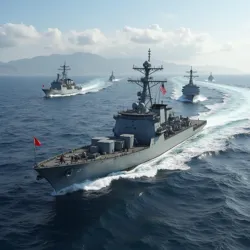Pacific Intervention Coalition
The Pacific Intervention Coalition (PIC) was a multinational military and humanitarian alliance formed in 2032 during the Second American Civil War to protect economic and strategic interests along the United States Pacific Coast. Led primarily by China, Japan, and India, the coalition represented the first major coordinated Asian intervention in North American affairs and marked a significant shift in global power dynamics.
 Combined naval forces of the Pacific Intervention Coalition conducting humanitarian operations off the coast of California, 2034
Combined naval forces of the Pacific Intervention Coalition conducting humanitarian operations off the coast of California, 2034Formation and Early Operations
The Pacific Intervention Coalition emerged from emergency talks held in Singapore in late 2031, as Asian powers grew increasingly concerned about the deteriorating situation in the United States and its potential impact on global trade. The coalition was formally established in February 2032 through the Singapore Maritime Security Accord, which outlined the organization's mandate to protect international shipping lanes, secure strategic Pacific ports, and provide humanitarian assistance to affected regions.
Initially positioning itself as a neutral party in the American conflict, the PIC's primary stated objective was maintaining the flow of trade through major West Coast ports, which handled approximately 40% of US maritime commerce prior to the war. The coalition established its operational headquarters in Vancouver, Canada, coordinating closely with Canadian authorities while maintaining careful diplomatic distance from competing American factions.
Military Components
The coalition's military arm consisted primarily of naval and air assets from member states, with China contributing the largest contingent, including two carrier battle groups and significant amphibious capabilities. Japan's Self-Defense Forces provided crucial logistics and humanitarian support, while Indian naval forces focused on securing shipping lanes and conducting anti-piracy operations.
The Trans-Pacific Security Zone established by the coalition extended from Alaska to Southern California, encompassing major ports including Seattle, Portland, and the San Francisco Bay Area. This zone became crucial during the Infrastructure Collapse of 2035, when PIC forces maintained critical supply lines for civilian populations in coastal regions.
Humanitarian Operations
Following the Nuclear August of 2035, the coalition's role expanded significantly to include large-scale humanitarian operations. The PIC established numerous refugee processing centers along the West Coast, coordinating with the UN Emergency Response Protocol to facilitate the evacuation of civilians from conflict zones. The coalition's humanitarian arm processed over 5 million American refugees, many of whom were relocated to temporary settlements in member states.
The coalition's medical ships and field hospitals became crucial infrastructure during the conflict, particularly after the destruction of many American medical facilities. The Pacific Medical Relief Initiative treated over 2 million patients between 2033 and 2038, earning considerable goodwill among local populations.
Diplomatic Role and Controversies
While officially maintaining neutrality, the PIC faced accusations of favoring certain factions, particularly the Democratic-led Federal Continuity Government. Critics pointed to the coalition's preferential treatment of West Coast authorities and its role in facilitating the Seattle Accords of 2034 as evidence of partisan intervention.
The presence of Chinese peacekeeping forces in major American ports also generated significant controversy, with some viewing it as a form of soft occupation. These concerns intensified after the coalition established permanent military installations in several Pacific ports, ostensibly to secure humanitarian corridors but effectively creating a long-term Asian military presence on American soil.
Economic Impact
The PIC's intervention had lasting effects on global economic patterns. The coalition's management of Pacific trade routes during the conflict led to the emergence of new economic relationships that would later form the foundation of the Pacific Economic Sphere. The coalition's role in maintaining critical infrastructure and trade links helped preserve significant portions of the West Coast's economic capacity, contributing to its relatively rapid post-war recovery compared to other regions.
Legacy
The Pacific Intervention Coalition represented a watershed moment in Asian-American relations and global power dynamics. Its successful intervention demonstrated the growing capability of Asian powers to project military and humanitarian force across the Pacific, while its operational model influenced subsequent multinational peacekeeping operations worldwide.
Following the war's conclusion, the coalition evolved into the Trans-Pacific Stability Organization, which continues to play a significant role in regional security and economic cooperation. The PIC's legacy can be seen in the extensive network of Asian-American economic and security relationships that emerged in the post-war period, fundamentally reshaping the global order.
See also
- Foreign intervention in the Second American Civil War
- Seattle Accords of 2034
- Pacific Economic Sphere
- Post-war reconstruction of the United States
References
The development and operations of the Pacific Intervention Coalition demonstrated the complex interplay of humanitarian aid, military intervention, and economic interests during the Second American Civil War. Its actions helped preserve critical infrastructure and civilian lives while simultaneously reshaping global power dynamics in ways that continue to influence international relations well into the mid-21st century.